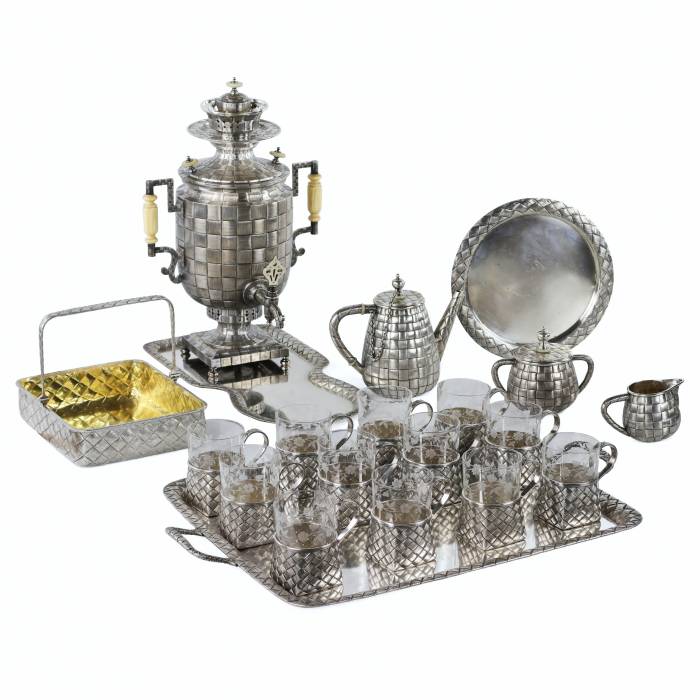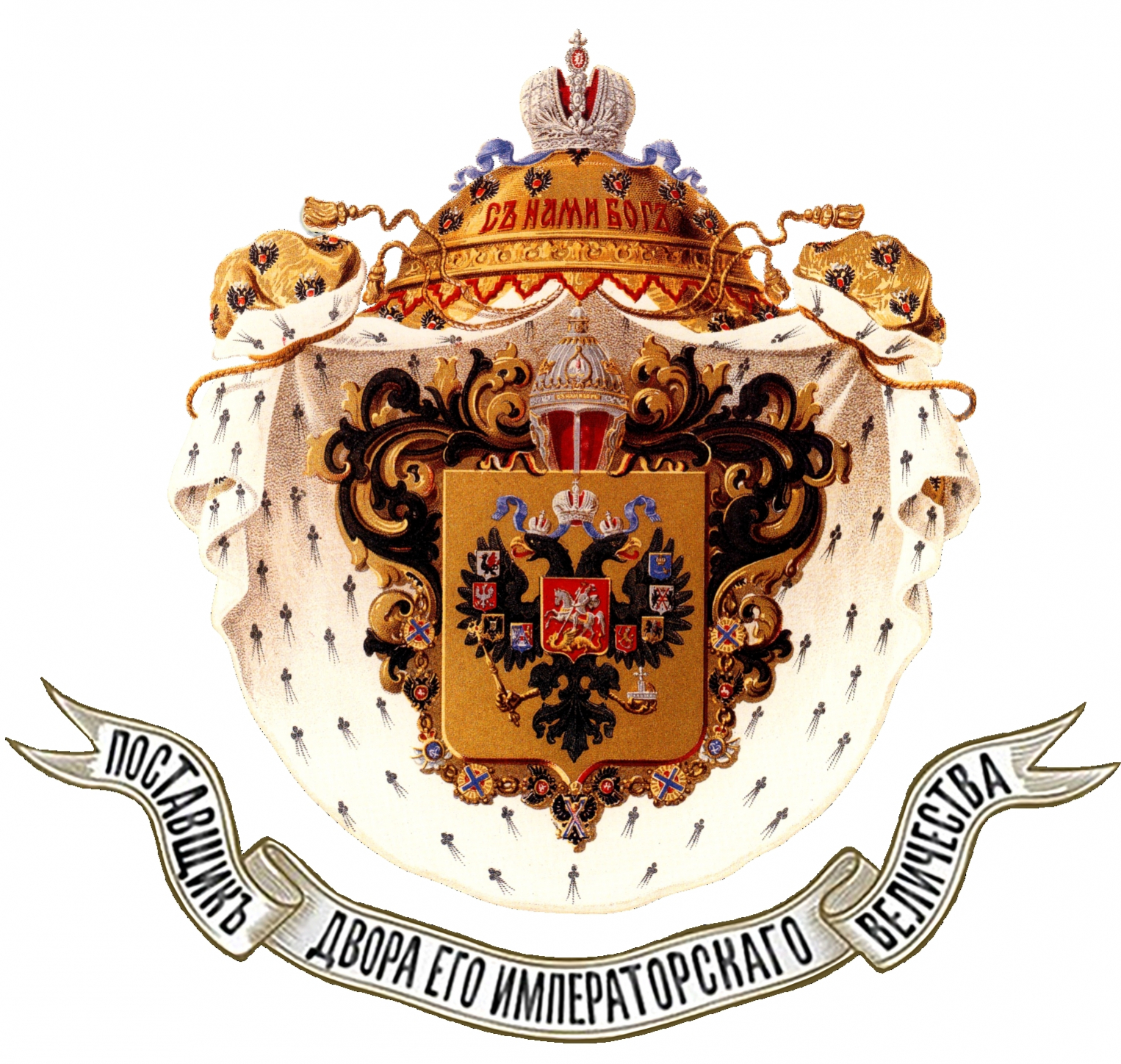
AntiqonART consultant will contact you within one business day after receiving your request.
Discover how the value of similar works has evolved over the past 10 years. Art is not only beauty — it's an investment.
Discover how the value of similar works has evolved over the past 10 years. Art is not only beauty — it's an investment.
Dimensions:
– Samovar : hauteur – 42 cm, largeur – 28 cm, poids – 3029 g
– Plateau sous le samovar : longueur – 42 cm, largeur – 23 cm, poids – 835 g
– Théière, pot à lait, sucrier : hauteur – 18 cm, longueur – 19 cm, poids total – 1180 g
– 12 porte-verres : hauteur – 8,5 cm, diamètre – 10 cm, poids total – 1400 g
– Grand plateau : longueur – 59 cm, largeur – 39 cm, poids – 2063 g
Poids total du service : 8507 g
MarquesPoinçon: complet de la maison des frères Grachev, poinçon ovale aux initiales JO pour le maître-orfèvre Johann Ferdinandovich Olsonius, poinçon rectangulaire aux initiales A.M. pour un orfèvre non identifié, poinçon de Saint-Pétersbourg daté 1884 avec les initiales de l’essayeur Alexander Franz von der Flit, numéro 84 confirmant un titre en argent de 84 zolotniks, poinçon circulaire avec ancres croisées et sceptre, emblème du bureau de garantie de Saint-Pétersbourg.
Le style néo-russe est un courant artistique né en Russie dans la seconde moitié du XIXe siècle, à une époque de quête active de l’identité nationale. Inspiré par l’esthétique de l’art ancien russe, l’architecture ecclésiastique et les arts populaires, ce mouvement réagit à la domination des canons européens occidentaux et exprime une volonté de renaissance culturelle et d’affirmation identitaire. Il s’inscrit dans un vaste courant idéologique cherchant à restaurer la continuité entre passé et présent en combinant la mémoire historique et les formes artistiques contemporaines.En architecture, le style néo-russe se manifeste par des formes inspirées de la Russie pré-pétrine : toitures en tente, coupoles, kokoshniks décoratifs, faïences polychromes, briques ornementales et riches sculptures. Dans les arts décoratifs, on retrouve des motifs anciens stylisés, des formes végétales courbes et des motifs géométriques traditionnels.Ce style connut un développement remarquable dans l’orfèvrerie. Les grandes maisons russes telles que celles de Carl Fabergé, Pavel Ovchinnikov et les Frères Grachev puisèrent dans les formes archaïques et la symbolique populaire. Leurs œuvres sont ornées d’émaux complexes, de gravures, de textures tressées et d’éléments décoratifs inspirés des contes et légendes russes. Ces créations incarnent l’excellence artistique de la Russie de la fin du XIXe siècle.
MAISON DES FRÈRES GRACHEV (1866–1918)
La maison des Frères Grachev, fondée à Saint-Pétersbourg dans la seconde moitié du XIXe siècle, fut l’une des plus prestigieuses manufactures d’orfèvrerie de l’Empire russe. Fournisseurs attitrés de la Cour impériale, les frères Grachev étaient réputés pour leur travail d’orfèvrerie d’une qualité exceptionnelle, leur maîtrise des émaux et des gravures, ainsi que leur style empreint de motifs nationaux dans la tradition néo-russe.Ils s’entourèrent des meilleurs artisans de l’époque : graveurs, ciseleurs, émailleurs et sculpteurs miniaturistes, souvent issus des ateliers renommés de Fabergé, Sazikov ou Ovchinnikov. Parmi eux se distingua Johann Olsonius, maître orfèvre d’origine finlandaise, reconnu pour la finesse de son travail, la rigueur stylistique de ses créations et leur haute valeur artistique. Ses œuvres, marquées de son poinçon personnel, étaient prisées comme cadeaux officiels et objets de prestige.D’autres maîtres tels que I.K. Zakharov, A.F. Martyanov et F.L. Soldatov contribuèrent également au rayonnement de la maison. Leurs productions incarnent l’âge d’or de l’orfèvrerie impériale russe.
JOHANN OLSONIUS (1823 – ?)
Johann Olsonius fut l’un des plus éminents orfèvres de la seconde moitié du XIXe siècle. Maître d’origine finlandaise, il apporta une contribution notable à l’école décorative de Saint-Pétersbourg. Formé à la croisée des traditions artisanales scandinaves et russes, il acquit rapidement une reconnaissance pour la pureté de ses lignes et le raffinement de son exécution.Collaborateur de la maison des Frères Grachev, il réalisa de nombreuses œuvres en argent d’une sobriété élégante et d’une technicité remarquable. Son poinçon I.O. figure sur des objets en repoussé, gravés ou dorés, souvent dans le style néo-russe ou historiciste.L’œuvre d’Olsonius reflète un équilibre rare entre retenue nordique et richesse décorative russe. Il excellait dans l’imitation textile, les motifs complexes et la symbolique, conférant à ses créations une profondeur artistique unique.
Le service est conservé dans un excellent état. La dorure est entièrement préservée. L’argent a conservé sa patine noble, les gravures et les éléments décoratifs sont nets et parfaitement lisibles. Les incrustations en os et en nacre sont intactes et bien préservées, tout comme les verres en cristal taillé. De légères traces du temps sont cohérentes avec l’âge de l’ensemble et renforcent son authenticité. La complétude du service, la qualité de son exécution et la clarté des poinçons en font un exemple remarquable de l’orfèvrerie russe.
The condition report is provided for informational purposes only.
It is not comprehensive and may not reflect all defects, restorations, alterations, or adaptations, as Antiqon does not perform professional conservation-level assessments. The information is based on a qualified, yet subjective, evaluation by our specialists.Before purchasing, we recommend consultation with an independent expert.Please also consult our Terms and conditions and Glossary A-Z, which contain important information on lot characteristics and sale conditions.
